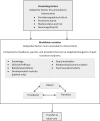Development and Content Validation of the Transition Readiness Inventory Item Pool for Adolescent and Young Adult Survivors of Childhood Cancer
- PMID: 29046041
- PMCID: PMC6251597
- DOI: 10.1093/jpepsy/jsx095
Development and Content Validation of the Transition Readiness Inventory Item Pool for Adolescent and Young Adult Survivors of Childhood Cancer
Abstract
Objective: The development of the Transition Readiness Inventory (TRI) item pool for adolescent and young adult childhood cancer survivors is described, aiming to both advance transition research and provide an example of the application of NIH Patient Reported Outcomes Information System methods.
Methods: Using rigorous measurement development methods including mixed methods, patient and parent versions of the TRI item pool were created based on the Social-ecological Model of Adolescent and young adult Readiness for Transition (SMART).
Results: Each stage informed development and refinement of the item pool. Content validity ratings and cognitive interviews resulted in 81 content valid items for the patient version and 85 items for the parent version.
Conclusions: TRI represents the first multi-informant, rigorously developed transition readiness item pool that comprehensively measures the social-ecological components of transition readiness. Discussion includes clinical implications, the application of TRI and the methods to develop the item pool to other populations, and next steps for further validation and refinement.
Keywords: adolescence; assessment; cancer; chronic illness; transition readiness.
© The Author 2017. Published by Oxford University Press on behalf of the Society of Pediatric Psychology. All rights reserved. For permissions, please e-mail: journals.permissions@oup.com
Figures



Similar articles
-
Stakeholder validation of a model of readiness for transition to adult care.JAMA Pediatr. 2013 Oct;167(10):939-46. doi: 10.1001/jamapediatrics.2013.2223. JAMA Pediatr. 2013. PMID: 23959392 Free PMC article.
-
Development and content validation of the Healthcare Transition Outcomes Inventory for young adults with type 1 diabetes.J Patient Rep Outcomes. 2019 Dec 19;3(1):71. doi: 10.1186/s41687-019-0163-9. J Patient Rep Outcomes. 2019. PMID: 31858284 Free PMC article.
-
A social-ecological model of readiness for transition to adult-oriented care for adolescents and young adults with chronic health conditions.Child Care Health Dev. 2011 Nov;37(6):883-95. doi: 10.1111/j.1365-2214.2011.01282.x. Child Care Health Dev. 2011. PMID: 22007989 Review.
-
Validation of Transition Readiness Assessment Questionaire in Turkish Adolescents with Diabetes.Balkan Med J. 2018 Jan 20;35(1):93-100. doi: 10.4274/balkanmedj.2016.1415. Epub 2017 Oct 17. Balkan Med J. 2018. PMID: 29039345 Free PMC article.
-
The Application and Evolution of the Social-Ecological Model for Adolescent and Young Adult Readiness for Transition: A Scoping Review.J Pediatr Health Care. 2025 May-Jun;39(3):355-376. doi: 10.1016/j.pedhc.2024.12.004. Epub 2025 Jan 7. J Pediatr Health Care. 2025. PMID: 39772328
Cited by
-
Barriers and facilitators of nurse-led self-management support for adolescents with epilepsy: A mixed-methods study in transition preparation.Heliyon. 2024 Jun 26;10(13):e33774. doi: 10.1016/j.heliyon.2024.e33774. eCollection 2024 Jul 15. Heliyon. 2024. PMID: 39071638 Free PMC article.
-
Introduction to the Special Issue on Adolescent and Young Adult Health: Why We Care, How Far We Have Come, and Where We Are Going.J Pediatr Psychol. 2017 Oct 1;42(9):903-909. doi: 10.1093/jpepsy/jsx101. J Pediatr Psychol. 2017. PMID: 29046043 Free PMC article.
-
Transition from pediatric to adult follow-up care in childhood cancer survivors-a systematic review.J Cancer Surviv. 2021 Feb;15(1):151-162. doi: 10.1007/s11764-020-00920-9. Epub 2020 Jul 16. J Cancer Surviv. 2021. PMID: 32676793
-
Recent Advances in Pathophysiology and Therapeutic Approaches in Epilepsy.Brain Sci. 2024 Aug 2;14(8):785. doi: 10.3390/brainsci14080785. Brain Sci. 2024. PMID: 39199478 Free PMC article.
-
Clinical, Sociodemographic, and Psychological Factors Associated with Transition Readiness in Patients with Epilepsy.Brain Sci. 2023 Dec 24;14(1):21. doi: 10.3390/brainsci14010021. Brain Sci. 2023. PMID: 38248236 Free PMC article.
References
-
- Armstrong G. T., Kawashima T., Leisenring W., Stratton K., Stovall M., Hudson M. M., Sklar C. A., Robison L. L., Oeffinger K. C. (2014). Aging and risk of severe, disabling, life-threatening, and fatal events in the childhood cancer survivor study. Journal of Clinical Oncology, 32, 1218–1227. - PMC - PubMed
-
- Bashore L., Bender J. (2016). Evaluation of the utility of a transition workbook in preparing adolescent and young adult cancer survivors for transition to adult services: A pilot study. Journal of Pediatric Oncology Nursing, 33, 111–118. - PubMed
-
- Betz C. L., Telfair J. (2007). Health care transitions: An introduction In Betz C. L., Nehring W. M. (Eds.), Promoting health care transitions for adolescents with special health care needs and disabilities (pp. 3–19). Baltimore, MD: Paul H. Brookes Pub.
-
- Cella D., Yount S., Rothrock N., Gershon R., Cook K., Reeve B., Ader D., Fries J. F., Bruce B., Rose M.; PROMIS Cooperative Group. (2007). The Patient-Reported Outcomes Measurement Information System (PROMIS): Progress of an NIH Roadmap cooperative group during its first two years. Medical Care, 45, S3–S11. - PMC - PubMed
-
- Children's Oncology Group. (2013). Long-term follow-up guidelines for survivors of childhood, adolescent, and young adult cancers version 4.0. Retrieved from www.survivorshipguidelines.org
Publication types
MeSH terms
Grants and funding
LinkOut - more resources
Full Text Sources
Other Literature Sources
Medical

